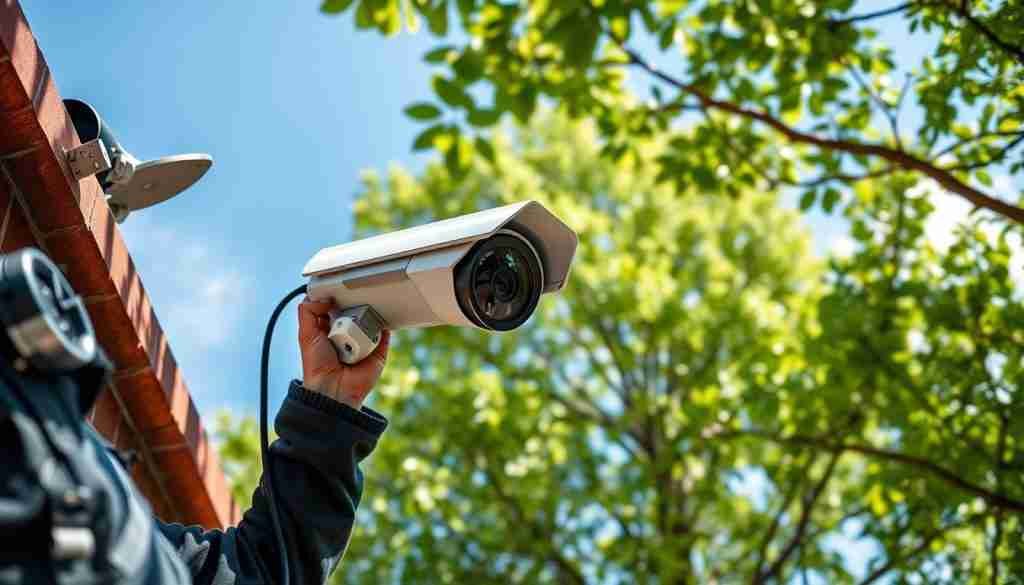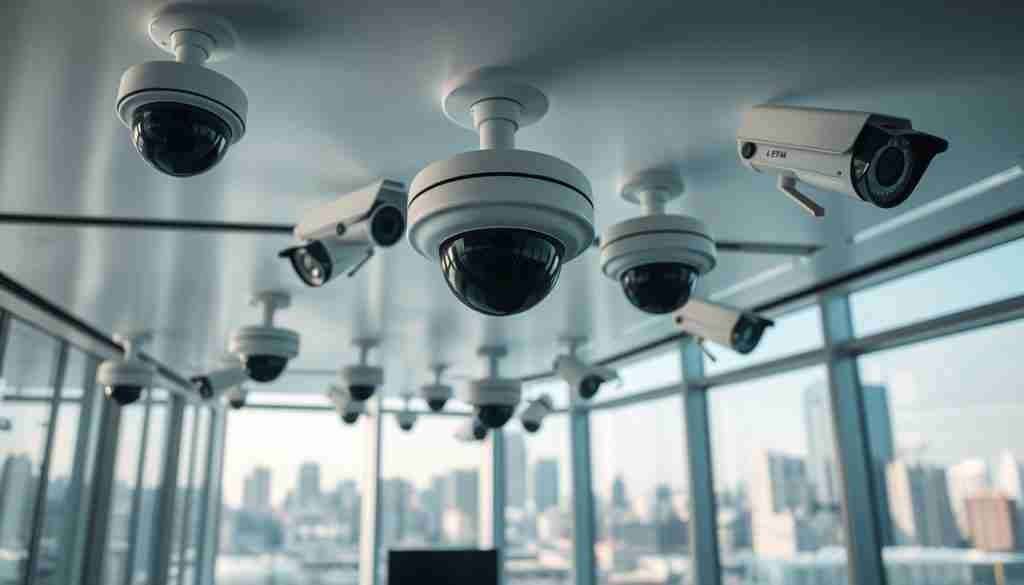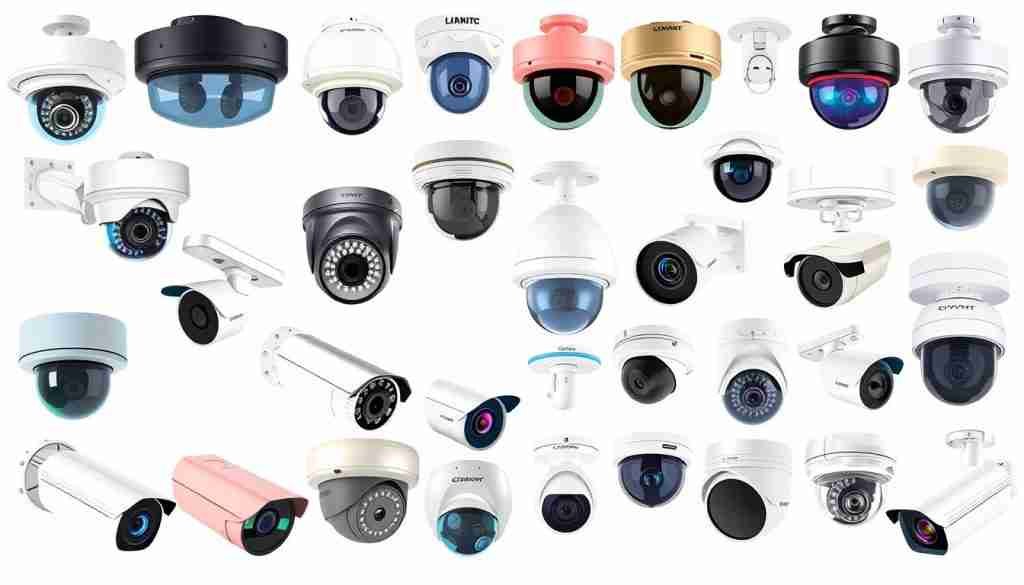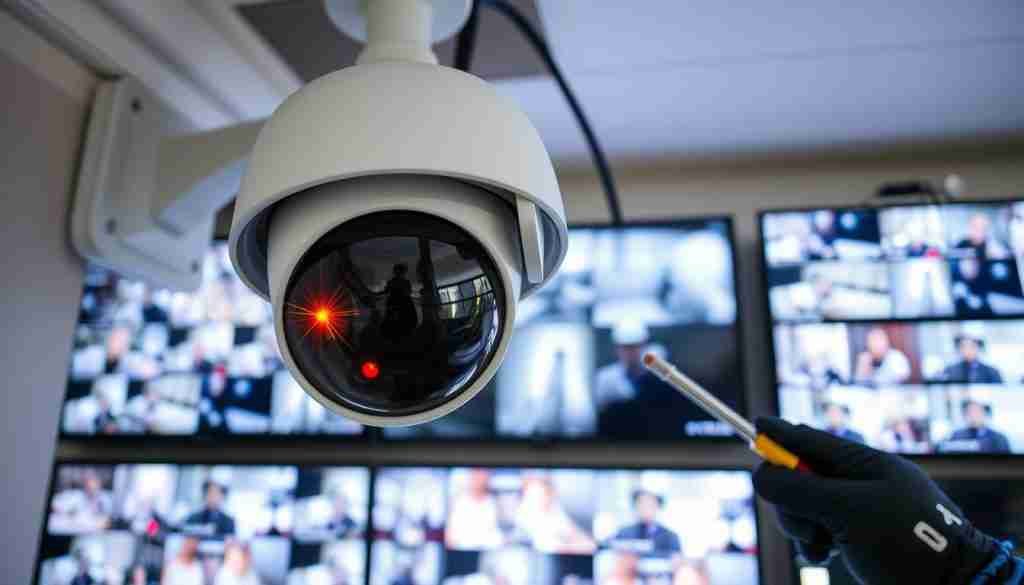In today’s world, security and privacy are key. The right placement of outdoor security cameras can protect your home and family. But, have you thought about where to put them for the best results? This guide will show you how to place cameras effectively, making your home safer.
Why Your Camera Positioning Matters
Where you put your security cameras is very important. It helps keep intruders away and captures important footage if needed. The right placement can boost your security, cover all areas, and prevent blind spots. So, is your camera setup ready to protect you? Let’s find out how to place cameras outside your home for the best protection.
Key Takeaways
- Understand the importance of strategic outdoor camera placement for comprehensive home security
- Identify common security vulnerabilities in home exteriors and how to address them
- Learn the optimal camera positioning for critical entry points like the front door and driveway
- Discover techniques to secure side entrances, windows, and the backyard area
- Explore advanced technologies and best practices for outdoor camera systems
Understanding the Importance of Outdoor Security Camera Placement
Effective home security starts with the right placement of your wireless outdoor cameras and smart home security cameras. Knowing how to place them well can make your home safer. It can also scare off potential intruders.
Key Benefits of Strategic Camera Positioning
Proper camera placement has many benefits:
- Enhanced coverage: Well-placed cameras cover more ground. They reduce blind spots and watch over all important areas outside your home.
- Improved deterrence: Visible cameras can scare off burglars. They make your home less appealing to them.
- Effective monitoring: Strategically placed cameras let you watch your home closely. You can quickly respond to any odd behavior.
Common Security Vulnerabilities in Home Exteriors
It’s key to spot and fix security weak spots outside your home. Common issues include:
- Doors and windows that aren’t well-protected
- Dark areas that intruders can hide in
- Landscaping that blocks camera views or creates hiding spots
Coverage Zones and Blind Spots
When setting up your wireless outdoor cameras and smart home security cameras, think about coverage zones and blind spots. It’s vital to cover all areas well and avoid blind spots for good home security.
Essential Entry Points: Front Door and Driveway Coverage
Securing your home starts with the front door and driveway. These areas need careful camera placement. Weatherproof security cameras and night vision security cameras are key for round-the-clock monitoring, no matter the weather.
A weatherproof security camera near the front door watches over visitors and deliveries. It’s built to handle all kinds of weather, ensuring you always have surveillance. Add a night vision security camera for clear views at night, covering your entrance fully.
At the end of your driveway or near the garage, a night vision security camera tracks cars coming and going. It lets you see who’s there, even when it’s dark. This boosts your property’s security.
Placing weatherproof and night vision cameras at your front door and driveway makes your home safer. It deters intruders and gives you evidence if needed.
| Camera Type | Recommended Placement | Key Benefits |
|---|---|---|
| Weatherproof Security Camera | Near the front door | Reliable surveillance in all weather conditions |
| Night Vision Security Camera | At the end of the driveway or near the garage | Maintains visibility and identification in low-light settings |
Investing in weatherproof and night vision cameras at key entry points gives you a strong security system. It protects your home 24/7.
Securing Side Entrances and Windows With Surveillance
Protecting your home’s exterior is more than just the front door. It’s also about keeping side entrances and windows safe. Use motion detection cameras and HD outdoor cameras to watch these areas closely. This helps keep intruders away.
Optimal Camera Heights for Side Areas
Choosing the right camera height is important for side areas. Place them at eye level, about 5-7 feet high. This height gives a clear view and helps spot any odd behavior.
Dealing with Landscaping Obstacles
- Trim any overgrown shrubs, trees, or plants that could block the camera’s view.
- Put cameras on high mounts or under eaves to see over plants.
- Use motion-activated lights to brighten dark spots and help your HD outdoor cameras work better.
Window-Specific Security Considerations
Windows need extra care, especially if they’re low or easy to reach. Make sure cameras cover the whole window. Also, think about using stronger glass to stop break-ins.
| Feature | Benefit |
|---|---|
| Motion detection cameras | Send alerts right away if they see movement, so you can act fast. |
| HD outdoor cameras | Give clear video that can prove who did something if your home is broken into. |
By placing cameras smartly around side entrances, windows, and plants, you make your home safer. This keeps intruders away and protects your home.
Backyard and Rear Property Surveillance Solutions
Securing your home’s exterior is crucial, especially the backyard and rear areas. These spaces are often less visible and can be at risk of intruders. Placing solar-powered security cameras and WiFi outdoor cameras in these spots is key for full protection.
Solar-powered and WiFi-enabled outdoor cameras offer many benefits. They can be installed anywhere without the need for wires. This makes them perfect for hard-to-reach spots in your backyard. Plus, they connect wirelessly to your smart home, sending alerts to your phone or tablet.
- Maximize coverage of large, open backyard spaces
- Discreetly monitor areas behind fences, sheds, or other structures
- Enjoy the convenience of solar-powered operation, eliminating the need for electrical outlets
- Integrate with your existing WiFi network for remote access and monitoring
By placing solar-powered security cameras and WiFi outdoor cameras around your backyard, you create a strong security system. It keeps intruders away and gives you important footage if something happens.
Creating a smart outdoor camera plan is vital for your home’s safety. It covers often-neglected backyard and rear areas. With the right technology and placement, you can feel safe and secure at home.
Security Cameras Outside Home: Best Practices and Positioning Tips
To keep your home safe, it’s key to place your outdoor security cameras right. Follow these tips for the best coverage and weatherproofing.
Weather Protection Strategies
Outdoor cameras need to handle rain, snow, and sun. Look for weatherproof security cameras that can stand up to different weather. They have strong, water-resistant bodies and parts that work well in extreme temperatures.
Lighting Considerations
Good lighting is essential for clear video, especially at night. Place your outdoor security camera systems near lights like porch or floodlights. Or, add motion-activated lights for extra light when needed.
Power Source Planning
Choosing the right power source is important for your camera’s performance. Consider solar-powered cameras or ones with rechargeable batteries. This way, you avoid complex wiring and keep your system running, even without power.
By using these tips, you can set up a strong outdoor security camera system. It will protect your home’s outside well.
Advanced Technologies for Outdoor Camera Systems
Technology keeps getting better, and so do smart home security cameras and night vision security cameras. These systems now have cool features that make your home safer and easier to watch.
One big change is how these cameras work with smart homes. Now, smart home security cameras can talk to your other smart stuff. This means you can watch and control your home’s security from anywhere. It makes keeping your home safe super easy.
Another cool thing is how night vision security cameras have improved. They can see better in the dark now. No more blurry pictures at night. You can watch your property day and night with crystal-clear images.
- Smart home integration for centralized security control
- Improved night vision capabilities for round-the-clock surveillance
- Advanced motion detection and intelligent alerts to prioritize your safety
- High-definition video quality for clear and detailed footage
- Weatherproof and durable designs to withstand outdoor elements
With these new techs, you can make your outdoor security better. You’ll feel safer knowing your home and family are protected.
Legal Considerations and Privacy Guidelines
When you set up outdoor security cameras, knowing the law and respecting your neighbors’ privacy is key. It’s important to understand local surveillance laws and notification rules. This ensures your system is both legal and ethical.
Neighbor Privacy Rights
Securing your home is important, but so is your neighbors’ privacy. Don’t point cameras at their private areas like backyards or windows. Talking to your neighbors and listening to their concerns helps keep peace and avoids problems.
Local Surveillance Laws
The rules for using security cameras outside your home differ by place. Check the laws in your area to make sure your security cameras outside home and outdoor security camera systems follow them. Some places need you to post signs or tell people they’re being watched.
Required Signage and Notifications
- Put up clear signs that show you have security cameras and surveillance.
- Send a written notice to your neighbors about your outdoor security camera systems.
- Be open about why and how you’re using your security cameras to build trust.
Following the law and respecting privacy helps you protect your home without hurting others. Being proactive about these issues makes your security system work better for you and your community.
Maintenance and Upkeep of Outdoor Security Cameras
Keeping your weatherproof security cameras and HD outdoor cameras in top shape is key. Regular care helps them last longer and work better, even in tough weather. This ensures your home surveillance system stays reliable and effective.
Cleaning and looking after your cameras is important. Use a soft, microfiber cloth to wipe the lens and body. This removes dirt and dust without harming the seals. Also, check the mounting hardware often and adjust it if needed to keep the camera steady.
For HD outdoor cameras, it’s vital to check for updates. Look for firmware and software updates to keep your camera’s image quality high. Also, make sure your camera’s video feed and network are working well. By taking good care of your outdoor cameras, you’ll get many years of protection for your home.
FAQ
Where should I place security cameras outside my home?
The best spot for outdoor security cameras depends on your home’s layout and weak spots. Place cameras at key spots like the front door, driveway, side entrances, and backyard. This gives you full coverage and boosts your home’s security.
What are the benefits of strategic camera positioning?
Outdoor security cameras placed right can keep intruders away and capture clear footage. They help monitor risky areas and reduce blind spots. It’s key to think about coverage zones and weak points for a strong security system.
How can I secure my front door and driveway with cameras?
Use weatherproof and night vision cameras to watch your front door and driveway. These cameras work 24/7. They help you see who’s there and spot any odd activity, even at night.
How do I secure my side entrances and windows with surveillance?
To protect your side entrances and windows, think about camera placement and obstacles. Use motion detection and high-def cameras to cover these often-neglected areas.
How can I improve backyard and rear property surveillance?
Adding cameras to your backyard and rear can add extra security. Solar and WiFi cameras are great for these big areas. They let you keep an eye on your outdoor space all around.
What best practices should I follow for positioning security cameras outside my home?
When setting up outdoor cameras, think about weather protection, light, and power. Choose weatherproof cameras and plan for these needs. This ensures your cameras work well for a long time.
What advanced technologies are available for outdoor camera systems?
Today’s outdoor cameras have smart features like home integration, better night vision, and smart motion detection. These techs make your outdoor cameras more secure and effective.
What legal and privacy considerations should I be aware of?
Be careful with neighbor privacy and local laws when using outdoor cameras. Know the rules and respect privacy. This way, you can use your cameras responsibly.
How do I maintain and upkeep my outdoor security cameras?
Keeping your outdoor cameras in good shape is key. Clean them regularly, protect them from the weather, and check their quality. This keeps your home safe and your cameras working well.









